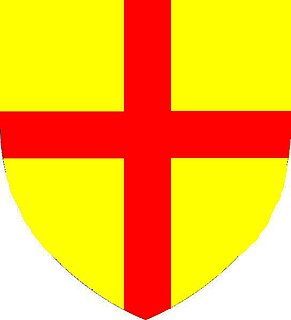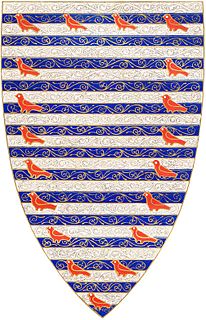
William Marshal, 1st Earl of Pembroke, also called William the Marshal, was an Anglo-Norman soldier and statesman. He served five English kings – Henry II, his sons the "Young King" Henry, Richard I, John, and John's son Henry III.

The Earldom of Pembroke is a title in the Peerage of England that was first created in the 12th century by King Stephen of England. The title, which is associated with Pembroke, Pembrokeshire in West Wales, has been recreated ten times from its original inception. With each creation beginning with a new first Earl, the original seat of Pembroke Castle is no longer attached to the title.

Earl Marshal is a hereditary royal officeholder and chivalric title under the sovereign of the United Kingdom used in England. He is the eighth of the Great Officers of State in the United Kingdom, ranking beneath the Lord High Constable and above the Lord High Admiral. A Duke of Norfolk has held the office since 1672.

Roger Bigod was 4th Earl of Norfolk and Marshal of England.

William de Valence, born Guillaume de Lusignan, was a French nobleman and knight who became important in English politics due to his relationship to King Henry III of England. He was heavily involved in the Second Barons' War, supporting the King and Prince Edward against the rebels led by Simon de Montfort. He took the name de Valence after his birthplace, Valence, near Lusignan.
Richard de Clare, 2nd Earl of Pembroke, Lord of Leinster, Justiciar of Ireland, also known as Richard FitzGilbert, was an Anglo-Norman nobleman notable for his leading role in the Anglo-Norman invasion of Ireland. Like his father, Richard fitz Gilbert has since become commonly known by his nickname Strongbow, which may be a mistranscription or mistranslation of "Striguil."

Hugh Bigod was a member of the powerful early Norman Bigod family and was for a short time the 3rd Earl of Norfolk.

William Marshal, 2nd Earl of Pembroke was a medieval English nobleman and was one of Magna Carta sureties. He fought during the First Barons' War and was present at the Battle of Lincoln (1217) alongside his father William Marshal, 1st Earl of Pembroke, who led the English troops in that battle. He commissioned the first biography of a medieval knight to be written, called L'Histoire de Guillaume le Mareschal, in honour of his father.
John FitzGilbert the Marshal of the Horses was a minor Anglo-Norman nobleman during the reign of King Stephen, and fought in the 12th century civil war on the side of Empress Matilda.

Gilbert Marshal, 4th Earl of Pembroke was the third son of William Marshal, 1st Earl of Pembroke and Countess Isabel, the daughter of Richard son of Gilbert, earl of Striguil.
Events from the 1100s in England.
Isabel de Clare, suo jure 4th Countess of Pembroke and Striguil, was a Welsh and Irish noblewoman and one of the wealthiest heiresses in Wales and Ireland. She was the wife of William Marshal, 1st Earl of Pembroke, who served three successive kings as Marshal of England. Her marriage had been arranged by King Richard I.
Eva Marshal (1203–1246) was a Cambro-Norman noblewoman and the wife of the powerful Marcher lord William de Braose. She was the daughter of William Marshal, 1st Earl of Pembroke, and the granddaughter of Strongbow and Aoife of Leinster.
Maud de Lacy was an English noblewoman, being the eldest child of John de Lacy, 2nd Earl of Lincoln, and the wife of Richard de Clare, 5th Earl of Hertford, 6th Earl of Gloucester.
Maud de Lacy, Baroness Geneville was a Norman-Irish noblewoman and wealthy heiress who inherited half the estates of her grandfather Walter de Lacy, Lord of Meath, upon his death in 1241. The lordships of Trim and Ludlow passed to her second husband Sir Geoffrey de Geneville, 1st Baron Geneville by right of his marriage to her; although she helped to rule and administer the estates in an equal partnership. She is sometimes referred to as Matilda de Lacy.
Maud Marshal, Countess of Norfolk, Countess of Surrey was an Anglo-Norman noblewoman and a wealthy co-heiress of her father William Marshal, 1st Earl of Pembroke, and her mother Isabel de Clare suo jure 4th Countess of Pembroke. Maud was their eldest daughter. She had two husbands: Hugh Bigod, 3rd Earl of Norfolk, and William de Warenne, 5th Earl of Surrey.
Margaret de Quincy, suo jure 2nd Countess of Lincoln was a wealthy English noblewoman and heiress having inherited in her own right the Earldom of Lincoln and honours of Bolingbroke from her mother Hawise of Chester, received a dower from the estates of her first husband, and acquired a dower third from the extensive earldom of Pembroke following the death of her second husband, Walter Marshal, 5th Earl of Pembroke. Her first husband was John de Lacy, 2nd Earl of Lincoln, by whom she had two children. He was created 2nd Earl of Lincoln by right of his marriage to Margaret. Margaret has been described as "one of the two towering female figures of the mid-13th century".

Walter Marshal, 5th Earl of Pembroke was the fourth son of William Marshal, 1st Earl of Pembroke and Countess Isabel, the daughter of Richard son of Gilbert, earl of Striguil.
Marshal is a surname, and may refer to:






